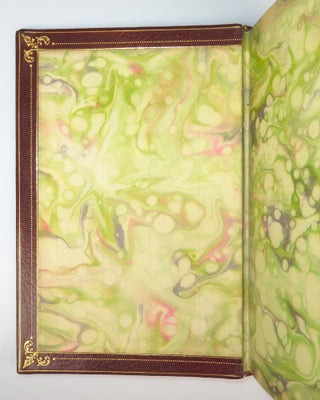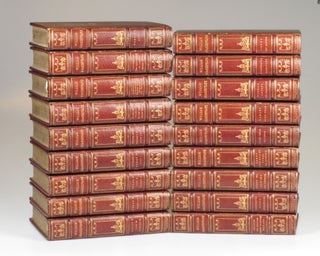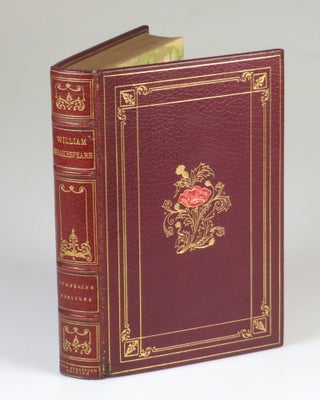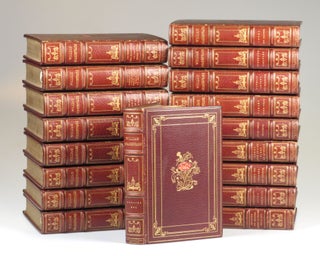The New Grant White Shakespeare. The Comedies, Histories, Tragedies, and Poems of William Shakespeare. Set Number 4 of the Old Stratford Edition, complete in 18 finely bound volumes
Boston: Little, Brown and Company, 1912. The finely bound, limited, and numbered "Old Stratford Edition" Full leather. These 18 finely bound volumes are a full set of "The Old Stratford Edition" of 1912 of the works of Shakespeare. Per the limitation statement, "This set is number 4" of the edition "limited to one hundred and twenty-four numbered sets." Each of this set’s volumes is magnificently bound in full brown Morocco goatskin. On each cover, elaborate gilt rule and decoration frame a gilt and red floral illustration. The spines feature raised and gilt decorated spine bands, gilt ruled and decorated compartments, and subtitle panels specifying the contents of each volume. The spine ends are gilt-hatched and the edges of the boards gilt ruled. Within, gilt-ruled and decorated turn-ins frame marbled endpapers. The contents are bound with red and gold silk head and foot bands and feature untrimmed fore and bottom edges and gilt top edges. The contents feature a profusion of illustrated leaves, each protected by a tissue cover with a red printed caption. The text is a “revised, supplemented, and annotated” version of that of prominent Shakespearean scholar Richard Grant White (1822-1885), who edited a multi-volume edition of Shakespeare’s works from 1857 to 1865. The set has a stately, commanding shelf presence, spanning nearly 2.5 feet (.75 meters) and weighing 34 pounds (15.4 kg).
Condition of the set is very good. All 18 bindings are square and tight, with no hinge breaks or compromises to binding integrity. The bindings show uniform, quite mild spine toning and minor wear primarily to hinges and extremities. The contents of all 18 volumes are truly fine. All appear complete, retaining a crisp feel with no spotting, no previous ownership marks, and light age-toning evident only to the otherwise clean fore and bottom edges. The gilt top edges remain respectably bright and clean. The original silk ribbon markers show varying levels of toning and deterioration where they protrude from the text blocks.
William Shakespeare (1564-1616) wrote at least 38 plays and over 150 short and long poems, many of which are considered to be the finest ever written in English. His works have been translated into every major living language (Folger)
However, even this fails to fully convey Shakespeare’s enduring stature, which so dominates English letters as to verge on biblical proportions. It is symbolically informative that Shakespeare is often assumed to have been born on 23 April, St. George’s Day, so that England’s national poet and their patron saint would share the same day of celebration, akin to the assertion of Christ’s birthday onto the winter solstice.
Shakespeare read from the standard syllabus of Latin literature and history: the history of Livy, the speeches of Cicero, the tragedies of Seneca, the poetry of Virgil, and Shakespeare’s favorite, Ovid, all of which became the foundational texts of his dramatic canon. He transmogrified much of his literary inheritance, making it his own and demonstrating not only skill but enormous range including “the frenetic farce within a potentially tragic frame of The Comedy of Errors; the learned, witty, verbal games and inconclusive ending of Love's Labour's Lost; the lyrical virtuosity and sharply personal politics of Richard II; the outrageous sexy comedy, romantic love, and tragic conclusion of Romeo and Juliet; and the metrical pyrotechnics and supernatural mechanism of A Midsummer Night's Dream.” (ODNB).
Shakespeare’s plays are the most conspicuous aspect of his literary legacy, but, “Shakespeare built up a double reputation in literature; as a classic English playwright and as author of the Sonnets, his profound meditations on love. In the plays we are frequently aware of Shakespeare the poet; in the Sonnets we recognize his role as dramatist. The author of the Sonnets became incomparably greater than his contemporaries precisely because he needed to see himself and his beloved in dramatic and human terms.” (Robert Graves). Item #007360
Price: $6,000.00







